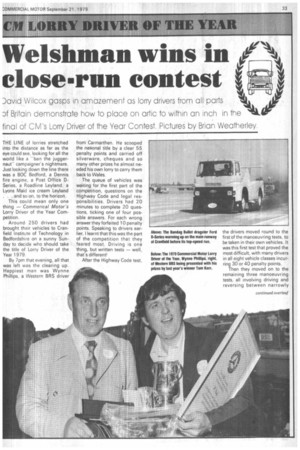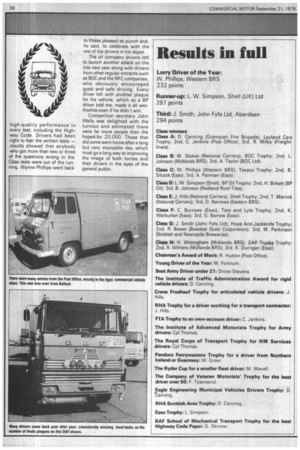Welshman wins in close-run contest
Page 35

Page 36

Page 37

Page 38

If you've noticed an error in this article please click here to report it so we can fix it.
David Wilcox gasps in amazement as lorry drivers from all parts
Df Britain demonstrate how to place on artic to within an inch in the final of CM's Lorry Driver of the Year Contest, Pictures by Brian Weatnerley.
THE LINE of lorries stretched into the distance as far as the eye could see, looking for all the world like a -ban the juggernaut" campaigner's nightmare. Just looking down the line there was a BOC Bedford, a Dennis fire engine, a Post Office DSeries, a Roadline Leyland, a Lyons Maid ice cream Leyland
. and so on, to the horizon.
This could mean only one thing — Commerical Motor's Lorry Driver of the Year Competition.
Around 250 drivers had brought their vehicles to Cranfield Institute of Technology in Bedfordshire on a sunny Sunday to decide who should take the title of Lorry Driver of the Year 1979.
By 7pm that evening, all that was left was the clearing up. Happiest man was Wynne Phillips, a Western BRS driver from Carmarthen. He scooped the national title by a clear 55 penalty points and carried off silverware, cheques and so many other prizes he almost needed his own lorry to carry them back to Wales, The queue of vehicles was waiting for the first part of the competition, questions on the Highway Code and legal responsibilities. Drivers had 20 minutes to complete 20 questions, ticking one of four possible answers. For each wrong answer they forfeited 10 penalty points. Speaking to drivers earlier, I learnt that this was the part of the competition that they feared most. Driving is one thing, but written tests — well, that's different!
After the Highway Code test, the drivers moved round to the first of the manoeuvring tests, to be taken in their own vehicles. It was this first test that proved the most difficult, with many drivers in all eight vehicle classes incurring 30 or 40 penalty points.
Then they moved on to the remaining three manoeuvring tests, all involving driving and reversing between narrowly spaced cones and stopping as close as possible to barriers but without actually touching. The aim of the test was to simulate the actual skills needed in everyday professional ,driving. This soon narrowed the field down as drivers — all local centre champions — suffered attacks of nerves and penalty points mounted.
By lpm the first class results were announced and the eight class champions were known. As always, the oil companies who attended in strength had done well.
For instance, in Class F, which covered the most articulated tankers, Esso, led by the 1975 champion Colin Burrows, took first, second and third places. Donald Canning from the Grampian Fire Brigade in Aberdeen beat a host of Post Office drivers from all over the country, collecting just 16' penalty points.
But National. Freight Corporation company drivers really came to the fore in the Class Finals and took the first places in Classes B, C. E and H. National Carriers and BRS companies were particularly strong.
There followed a break in the championship driving, giving the eight finalists a breather and letting the crowd look at some of the other attractions besides skilful driving on view at the massive Cranfield site.
In the early part of the afternoon there was a cavalcade of historic commercial vehicles provided by the Commercial Vehicle and Road Transport Club and sponsored by ERF. These vehicles dated back as far as 1913 and included a splendid 1 930 Sentinel steam wagon angrily blowing off steam and chugging along at a tidy pace.
Also on display was the very first ERF, built in 1933 and restored by the company's appren
tices in 1971. It set the standard in its day and with its Gardner engine will still go up hill and down dale at a steady 40mph.
Meanwhile, right back in the 1970s was the Bandag Bullet, the amazing-looking Ford DSeries-based dragster. This brilliant yellow monster is powered by a Ford six-cylinder turbocharged engine, developing around 300bhp. With a body custom-built around a Ford D 1314, 120in tipper chassis cab, this strange bewinged vehicle blasted down the main runway at Cranfield to hit 94.6mph from a standing start, almost disappearing in a cloud of black exhaust smoke.
Before it had taken over the runway, the airfield had been busy with lorries of all shapes and sizes being tried out by drivers and operators. Merceces-Benz, MAN, Volvo, Scania, and Dodge were just a few of the manufacturers who brought vehicles for demonstration and people had the opportunity to try out vehicles they had previously just admired from a distance.
Many others were on display and BRS Rescue was demonstrating how it can right an overturned lorry, while Volvo was letting people see. how economically they could drive a Volvo F10 and F12 for a first prize of a Volvo car.
But at 5pm the serious work started again and the eight Class Champions came out to do battle for the overall title. For the finals, the drivers abandoned their own vehicles and all drove in turn each of four vehicles provided by Leyland. So four of the drivers who until now had driven only rig ids had to try their hands at an artic as well, They was a Leyland EA van, a Boxer, a Reiver with a tipper body and a Marathon 2 with 40ft box trailer in a fetching livery of silver grey and black.
The manoeuvring tests were very tight and left no room for error. Nerves got the better of Class B winner Malcolm Stokes and he reversed very neatly but into the wrong "garage"! On the test using the Boxer, the drivers had to manoeuvre in between tapering lines as far as possible without crossing them, both forward and in reverse.
In the Reiver the finalists had to place in turn a front and back wheel in a box target on the ground as accurately as possible. Several of the drivers managed this with uncanny skill. Finally, using the Marathon and box trailer outfit. the drivers had to manoeuvre between cones set up by themselves as close as possible to the side of the vehicle as they dare. When reversing, the trailer rear had to stop directly above a painted line. This again was managed with spot-on accuracy, particularly .by Wynne Phillips.
The remarkable thing about these tests was how the drivers adapted to different vehicles. Van drivers handled the artic as though they drove one all day long, while the artic drivers manoeuvred the tipper with almost nonchalant ease. The crowd was obviously impressed.
When each driver had driven all four vehicles, it was down to the paperwork and adding up the penalty points. The RAF handled the results system with commendable skill and speed.
On the dot of 6.30pm the final results were announced. Third with 294 penalty points was John Smith of John Fyfe Ltd, Aberdeen. He was an artic driver who had won his class with not the easiest of vehicles, a Guy. Runner-up was Wilt Simpson from Shell's Sheffield depot with 287 points. His regular vehicle is a Scammell rigid oil-tanker but he adapted very well to the artic.
Finally, collecting his armful of prizes-from last year's winner Tom Kerr, was Wynne.Phillips. His everyday vehicle back at the Western BRS Carmarthen depot is a Leyland box-van, but he told me later that he thought the artic was the easiest test, although all had been difficult. In fact in the finals he incurred most penalty points on his own class of vehicle.
But his total of 232 penalty points reflected his consistently high-quality performance in every test, including the Highway Code, Drivers had been right to fear the written tests — results showed that anybody who got more than two or three of the questions wrong in the Class tests were out of the running. Wynne Phillips went back to Wales pleased as punch and, he said, to celebrate with the rest of the drivers in his depot.
The oil company drivers left to launch another attack on the title next year along with drivers from other regular entrants such as BOC and the NFC companies, who obviously encouraged good and safe driving. Every driver left with another plaque for his vehicle, which as a BP driver told me, made it all worthwhile even if he didn't win.
Competition secretary John Wells was delighted with the turnout and estimated there were far more people than the hoped-for 20,000. Those that did come went home after a long but very enjoyable day which must go a long way to improving the image of both lorries and their drivers in the eyes of the general public.












































































































































